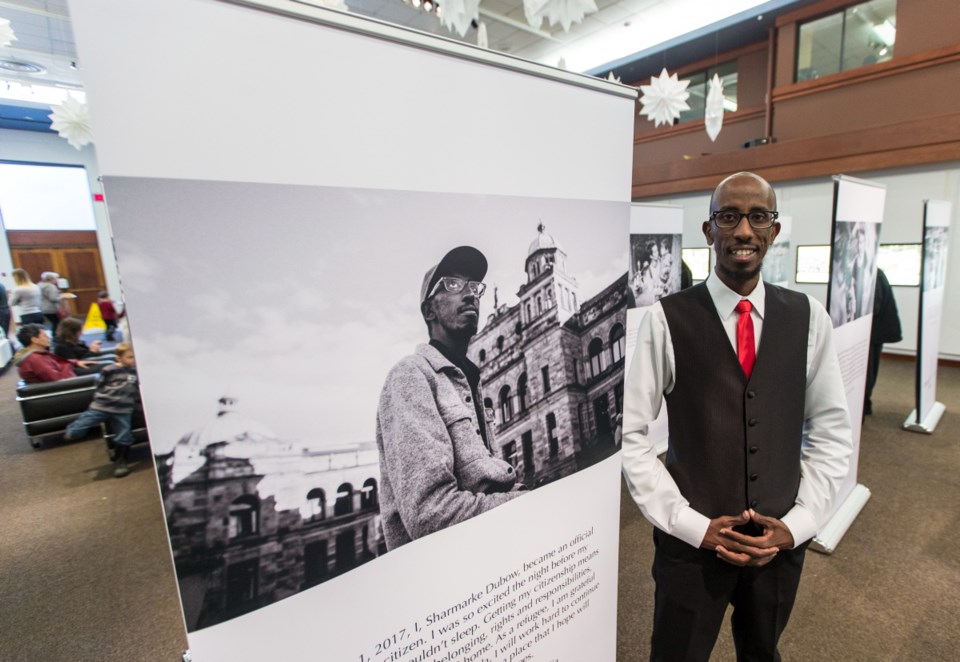What it means to be Canadian is difficult to put into words, but for Sharmarke Dubow, it was summed up during a recent return to Victoria from the U.S.
The Somali refugee was questioned thoroughly by U.S. border patrol agents when he entered Seattle before Christmas, but when he returned to Canada through the Coho ferry terminal, the Canada Border Services Agency officer said: “Welcome home.”
“I almost cried,” said the 34-year-old, who has been living in Victoria since 2012 and became a Canadian citizen on Canada Day last year. “I’ve been looking for over 20 years for a place to call home.”
Dubow is one of 26 people featured in a free exhibit at the Royal B.C. Museum called I’ve Not Always Been Canadian. In the exhibit, immigrants, refugees and Indigenous people reflect on Canadian identity and belonging.
Just outside the museum’s gift shop, the tall white panels feature black and white portraits of 26 people with a snippet of their personal story below.
Dubow’s journey to Canada needs more than a snippet to tell. It weaves through five countries, across an ocean in a crowded boat, under tents in a refugee camp and in the ivory tower of a university. It ends, for now, in Victoria after a quintessentially Canadian backpacking trip across four provinces.
Dubow was born on Christmas Day 1983 in Mogadishu, the Somali capital. Despite his parent’s separation at age six, Dubow and his older sister had a happy childhood. However, by the late 1980s, the country was hit with civil unrest, which escalated into civil war in 1991.
A year later, wanting to spare her children the violence of war, Anab Hussein put her son and daughter onto an overloaded boat heading for Kenya.
Reflecting on this, Dubow quotes Somali-British poet Warsan Shire: “You have to understand, no one puts their children in a boat, unless the water is safer than the land.”
After three days, the boat reached Mombasa on the coast of Kenya. Kenyan border officials initially prevented the boat from landing until the United Nations High Commissioner for Refugees intervened.
Dubow and his sister were placed in the Utanga refugee camp and eventually were joined by their mother.
In the camp, Dubow lived as normal a life as possible but had little chance for an education.
When the refugee camp closed around 1997, Dubow’s family moved to Ethiopia. While he was an undocumented migrant, his relatives paid for him to attend a private school called School of Tomorrow in Addis Ababa.
Dubow will never forget the American teacher “who gave me a chance.” He quickly rose to the top of his class and discovered his love of learning.
Dubow’s aunt persuaded him to move to Egypt, where he finished high school and completed a degree in business and technology from Cape Breton University, which runs the Canadian International College in Cairo.
In 2010, Dubow was sponsored by a family member to move to Winnipeg.
“I kissed his forehead when I arrived,” he said.
After searching online, Dubow connected with North Africans across Western Canada and headed toward Vancouver on a backpacking trip.
Based on his experience working with migrants and refugees in Egypt, Dubow was offered a job at the Victoria Immigrant and Refugee Centre Society.
Dubow now works for the Inter-Cultural Association, connecting refugees with support services.
“That’s where most of my passion comes from … my life experience,” he said.
Dubow said he takes pride in Canada’s model of settling newcomers, which focuses on integration rather than assimilation.
“Canada is the only country were a 16-year-old refugee can become minister of immigration, refugees and citizenship,” Dubow said, referring to Immigration Minister Ahmed Hussen.
“It also reminds me that my migration story is the Canadian story. Regardless of where you come from in the world, you belong here.”
Museum exhibit
The exhibit was assembled by the Inter-Cultural Association, which received a $15,000 Canada 150 grant. The grants were offered through a collaboration involving the Victoria Foundation, Community Foundations of Canada and the Government of Canada. Storyteller Lina de Guevara heard more than 100 personal stories and worked with photojournalist Quinton Gordon, who took the portraits on display in the Royal B.C. Museum. The exhibition continues until Tuesday, Jan. 9.



